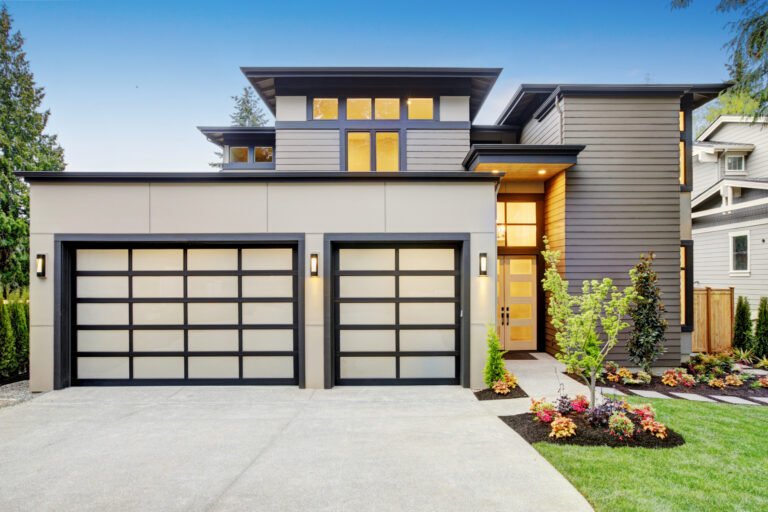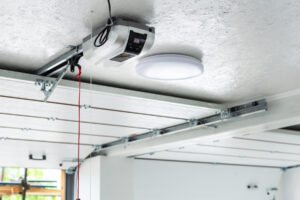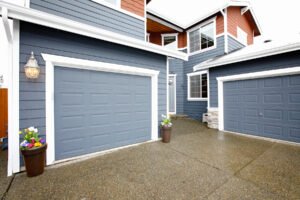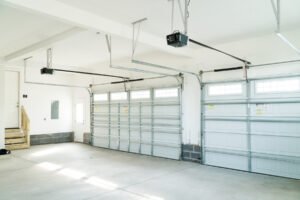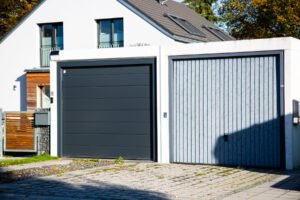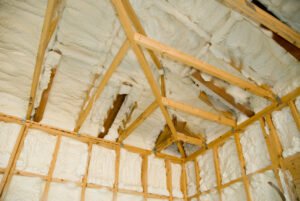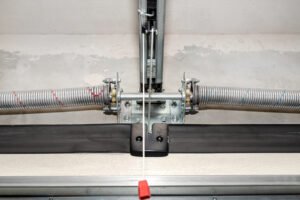A traditional garage door usually lasts 15-20 years, but it can rust, corrode or dent if not maintained. And, as unsecured and flimsy as it is, a dented garage door isn’t a great sight to witness, right? And, of course! Getting a new garage door now and then is unfair on your pockets and facade decor.
Different garage door alternatives that enhance security economically are a boon in such cases. So, let’s explore the 7 most effective garage door alternatives in detail, along with their pros and cons, to save you from spending additional bucks on a new garage door!
Why Should You Consider Garage Door Alternatives for Your Home?
Any conventional residential garage door can weather, discolor, expand, or contract when exposed to extreme temperatures and might fail way before its ideal lifespan.
Plus, it uses a lot of space and a high-tech mechanism that might not be suitable for all. But garage door alternatives are cheaper, easy to replace, and come with several benefits listed below.
- Enhanced Security: Most garage door alternatives come with a strong traditional padlock. Thus, they are more secure and curb the risks of burglary efficiently.
- Cost-Effective: These alternatives are more budget-friendly and start at $300-500. They are easy to maintain and do not incur high maintenance or repair costs.
- Ease of Customization: Garage door alternatives are incredibly flexible and can be customized, painted, or automated easily, unlike traditional garage doors.
- Flexibility: Garage door alternatives offer transition and spill-over spaces to converted offices, workspaces, and craftsman areas and look more flexible, unlike traditional garage doors.
- Privacy: These alternatives can be fully opened, partially opened, or shut entirely as you need, allowing you better control over privacy.
A List of Garage Door Alternatives for a Flexible Garage Space
Surprisingly, garage door alternatives come with an array of materials, textures, sizes, and mechanisms, each with different usability and function. Below are the most effective garage door alternatives for every application, with their pros and cons and other details!
1. Barn Doors
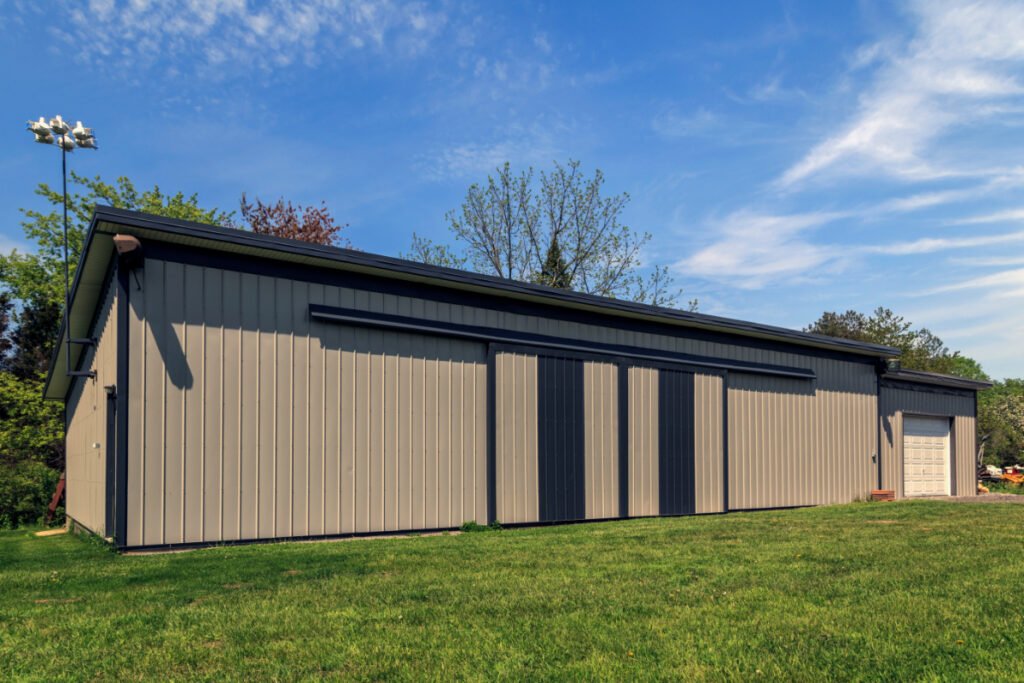
What Is It: Barn doors are sliding steel or wooden doors with equally divided bays, vertically grooved flush panels, and solid metal hardware that mounts the door against a horizontal track against the top surface.
A barn door is simple, rustic, and extremely easy to install and repair. It adds a lovely countryside charm to your garages and can be easily customized or chamfered to its measurements. However, it’s a little expensive and labor-intensive to install but lasts longer and offers greater insulation than rolling and glass garage doors.
Moreover, barn doors are thinner and light-weight than real wood doors and are pretty easy for DIY installations. You can even reglaze any old wood door or purchase a barn door kit to save more money.
The barn doors are the right option for noise-free garage doors and allow complete control over the door opening and operations.
| Average Weight | 150 – 200 lbs |
| Average Lifespan | 15 – 20 years |
| Standard Size | 36” X 84” |
| Decor | Countrystyle, Craftsman, or Farmhouse |
| Popular Materials | Pinewood, Cedarwood, Metal, or Steel |
Pros:
- Versatile and Adjustable
- You can refinish it with any stain or color of your choice
- Allows control over the door operations
- Adapts to any automatic garage door opener
- Offers a clear, unrestricted driveway
Cons:
- Quite expensive until you reglaze an existing one
- Labor-intensive
- Takes up more space
Rub white vinegar or olive oil along the rollers and tracks of any barn door to reduce friction and squeak.
2. Sheet Metal Door
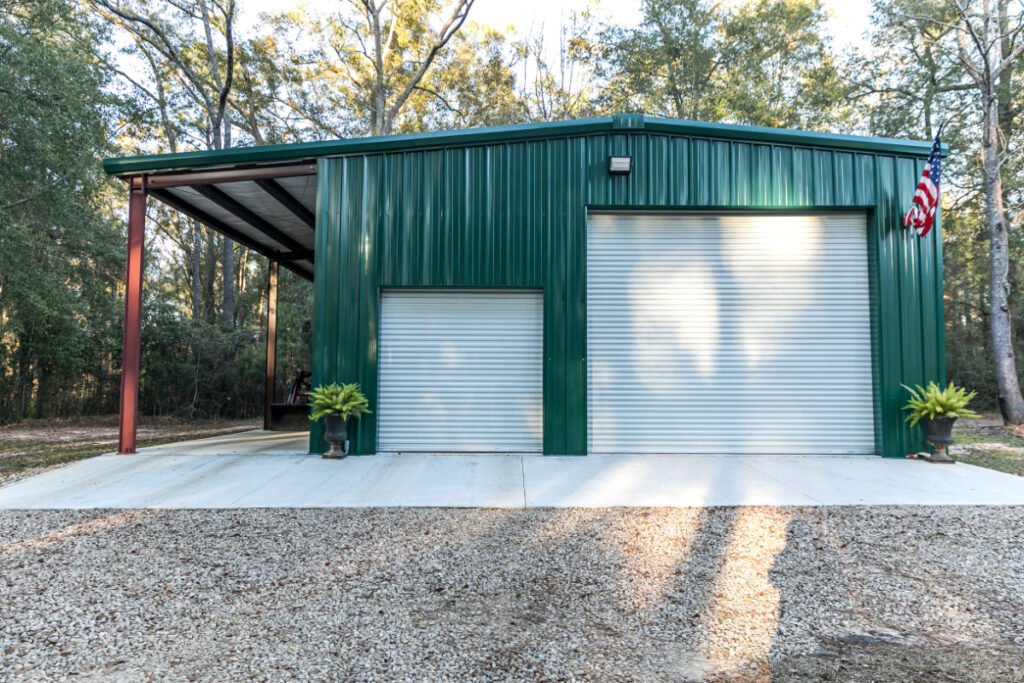
What Is It: A sheet metal door is a flat, cold-processed metal door with sectional surfaces and an easy coiling mechanism like a conventional roller door.
A sheet metal door is undoubtedly the most lightweight, workable, and budget-friendly garage door alternative available. But it can dent or weather easily and requires maintenance. Additionally, it does not offer proper insulation and can be pretty noisy if not lubricated or oiled.
You can use sheet metal for any typical overhead, sliding, or DIY side-hinged door that opens outwards, providing a clear garage space inside. You can also add standard latches or sliding garage door locks to keep them airtight and secure.
Overall, sheet metal doors are thin, grooved, and require some maintenance to withstand extreme climatic zones.
| Average Weight | 110 – 120 lbs |
| Average Lifespan | 10 – 15 years |
| Standard Size | 7 X 3 feet |
| Decor | Modern, Industrial, or Eclectic |
| Popular Materials | Sheet metal finished with Aluminum, Nickel, or Brass |
Pros:
- Affordable and Customizable
- Easy to install
- Workable and easy to cut according to your opening size
Cons:
- Looks crude and unfinished
- Are quite loud in cold climates and might freeze in place
- Gets discolored and dents easily
Use a sharp, heavy-duty hacksaw or metal grinder, or prefer smaller tin snips to cut the sheet metal efficiently.
3. Roll Up Door Screen
What Is It: A Roll up garage door screen is like a meshed fabric and a visual barrier that prevents pests, bugs, and rodents from entering your garage. It has a 0.25” thread weave and a yellow, black, gray, or blue screen with a water-resistant bottom seal.
Roller door screens are durable and flexible and can be easily stretched over one-car and two-car garage door frames. These are affordable and keep the sun and mosquitoes away.
However, they are not secure in a true sense and can be easily cut down during burglary. Hence, it’s always advisable to mount these on thin steel garage doors for more protection.
Nevertheless, a roll up door screen is a great option for garage workshops as it allows sufficient natural light and ventilation into the space. Plus, you can even use simple magnetic locks to open and close the door and save yourself from the hassle of buying a garage door opener.
| Average Weight | 6 – 15 lbs |
| Average Lifespan | 3 – 7 years |
| Standard Size | 38” X 82” |
| Decor | Looks Rustic and Farmhouse-style |
| Popular Materials | Fire retardant cloth, Aluminum, Plastic, Fiberglass Roll, or Composite Material |
Pros:
- Inexpensive and Easy to install
- Keeps dust, rain, and pests away from your garage
- Welcomes natural light and ensures good ventilation
- Available in various colors and textures to suit your decor
Cons:
- Isn’t secure and won’t keep your garage safe
- Doesn’t hold onto heavier glass wool or foam insulation
- Manually operated
Roll-up door screens melt and deform in scorching temperatures exceeding 120°F and need to be installed with wood or sectional garage doors.
4. Carriage Doors or Side-hinged Doors
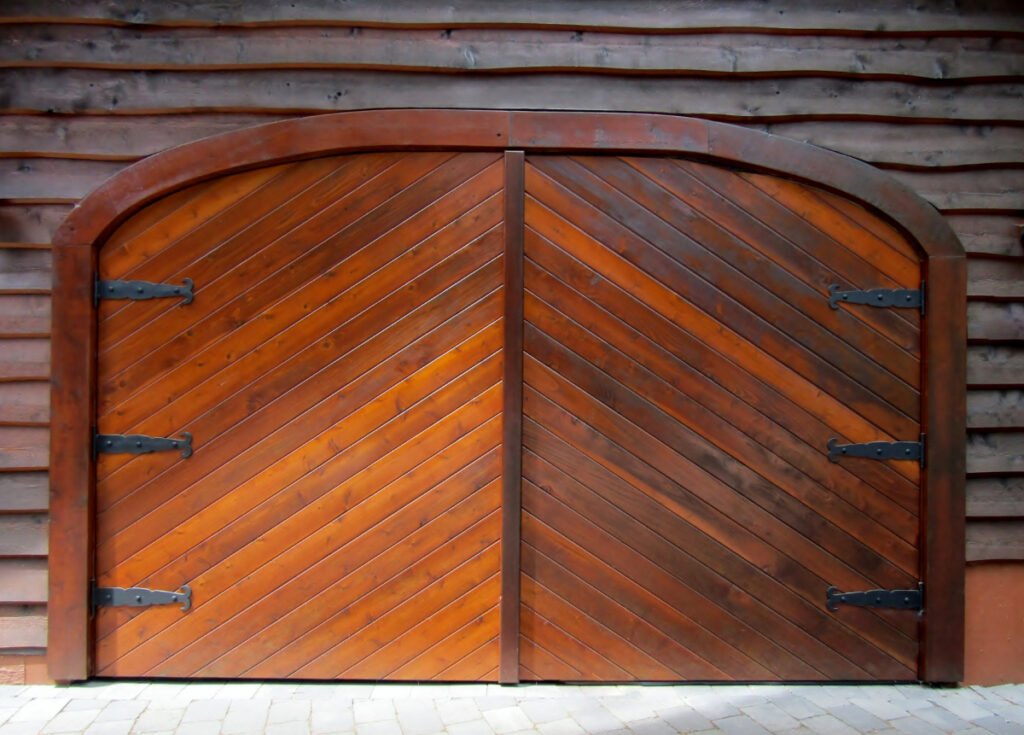
What Is It: Carriage doors are thick wood or steel doors with rectangular, doubly-fitted windows and equally divided bays that swing out when you open them.
Carriage doors are minimal, durable, and weather-resistant. They have a latch in the middle and 2-3 hinges with good-quality extension springs at the sides, making door opening easier and more convenient.
And these are really aesthetic and work with both electric and automatic garage door openers. Plus, they are available in various styles as follows:
- Traditional Carriage Doors: Classic, stained or painted wooden doors with squarish windows and a thicker section that keeps the garage warm and cozy.
- Contemporary Carriage Doors: A Galvanized or Alloyed Steel or Fiberglass door with a thin, lightweight section and a crisp, ultramodern or industrial finish.
| Average Weight | 200 – 350 lbs |
| Average Lifespan | 25 – 35 years |
| Standard Size | 8 X 7 feet |
| Decor | Traditional, Modern or Eclectic |
| Popular Materials | Steel, Wood, Aluminum, Fiberglass |
Pros:
- Gives a clear ceiling and attic space
- Allow more natural light and save energy costs
- Provides good insulation
- Sturdy and Difficult to break into during burglary
Cons:
- Difficult and expensive to automate
- Might obstruct the driveway
- Quite expensive and requires proper maintenance
Carriage doors are vulnerable to weathering or discoloration over time and need to be coated with a fine layer of elbow grease or dry silicon lubricant to last longer.
5. Sliding Garage Doors
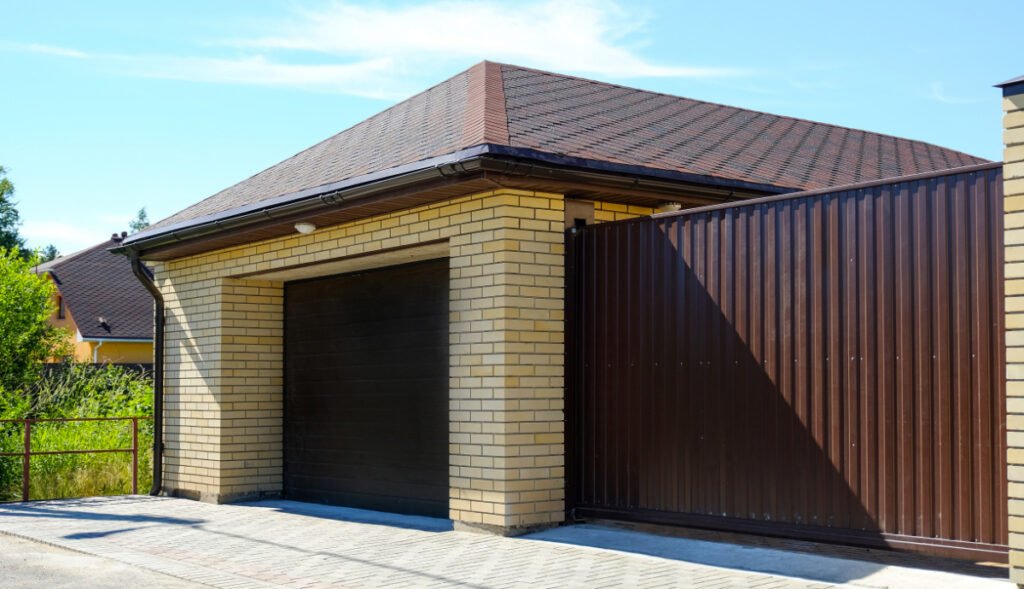
What Is It: Sliding doors are thicker wood or steel doors that run along horizontal tracks using a button or remote or through manual sliding. Additionally, these doors may have grooved or glass panels for better aesthetics and modern appeal.
A sliding door is not only durable and versatile but saves space and offers a clear driveway. It is expensive, heavy, and challenging to operate but can be enhanced using retractable motors or heavy-duty, battery-operated garage openers.
These even allow a clear garage space and protect from extreme weather conditions, heat, and rain. Overall, these are larger and can easily be used as extensive residential or commercial garage doors.
You can also club these with a durable garage door material like steel or wood for a greater lifespan. Additionally, these are compatible with automatic openers, remotes, and even keyless pads and are convenient for the elderly.
| Average Weight | 130 – 200lbs |
| Average Lifespan | 10 – 15 years |
| Standard Size | 8 X 6 feet |
| Decor | Contemporary or Mid-century modern |
| Popular Materials | Fiberglass, Wood, and Steel |
Pros:
- Do not obstruct the driveway and allow a clear garage
- Versatile and Durable
- Can be mounted both internally and externally
- Add a modern appeal and do not require much maintenance
Cons:
- Heavier to Operate and Slide manually
- Expensive
- Aren’t airtight and need appropriate garage door insulation
- Cannot work on sloping sites
Lubricate the door’s hinges, tracks, and rollers with silicone spray or plumber’s grease to keep them in good condition and prevent rusting.
6. Faux Wood Doors
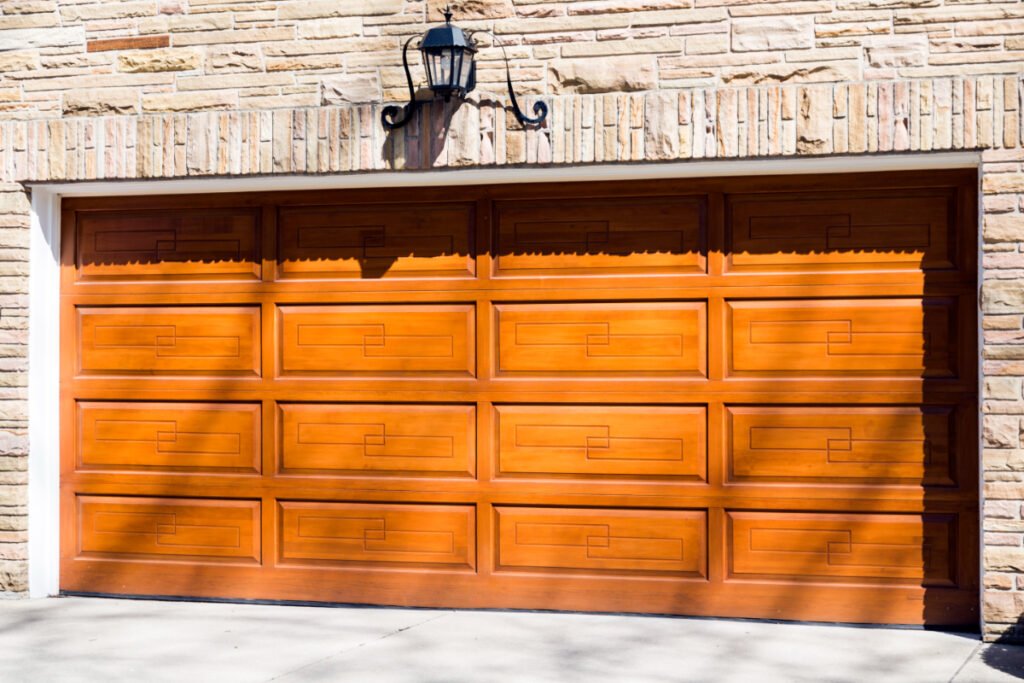
What Is It: Faux wood door is a PVC or composite material door that mimics the appearance of a typical wooden garage door but can be modified to enhance durability and climate resistance.
Faux wood is an excellent option for a traditional door and replicates the richness, grains, and luxurious feel of wood garage doors, minus the maintenance and reglazing. Plus, these are sturdier and come in various stains and finishes to suit your home decor. Unlike most alternatives, these increase the resale value and come with a warranty period.
And you can easily use them with various door styles like swing-out, sliding, tilt-up, or an overhead door with typical vertical sections. Further, they are easily repairable, and you can fix any chips or cracks with good-quality fiberglass fillers to help them last longer.
| Average Weight | 100 – 120lbs |
| Average Lifespan | 15 – 20 years |
| Standard Size | 80” X 96” |
| Decor | Traditional, Villa-style, or Vintage |
| Popular Materials | PVC, Fiberglass, Acrylic |
Pros:
- Durable and Long-lasting
- Available in a variety of stains, paints, and finishes according to your home decor
- Easy to Maintain and Lubricate
- Easily Repairable
Cons:
- Cost and labor-intensive
- Might not provide good garage door insulation
- Difficult to install or mount
Clean faux wood doors with non-abrasive dish soap and warm water once a month to keep them in good condition and prevent any discoloration.
7. Folding Garage Doors
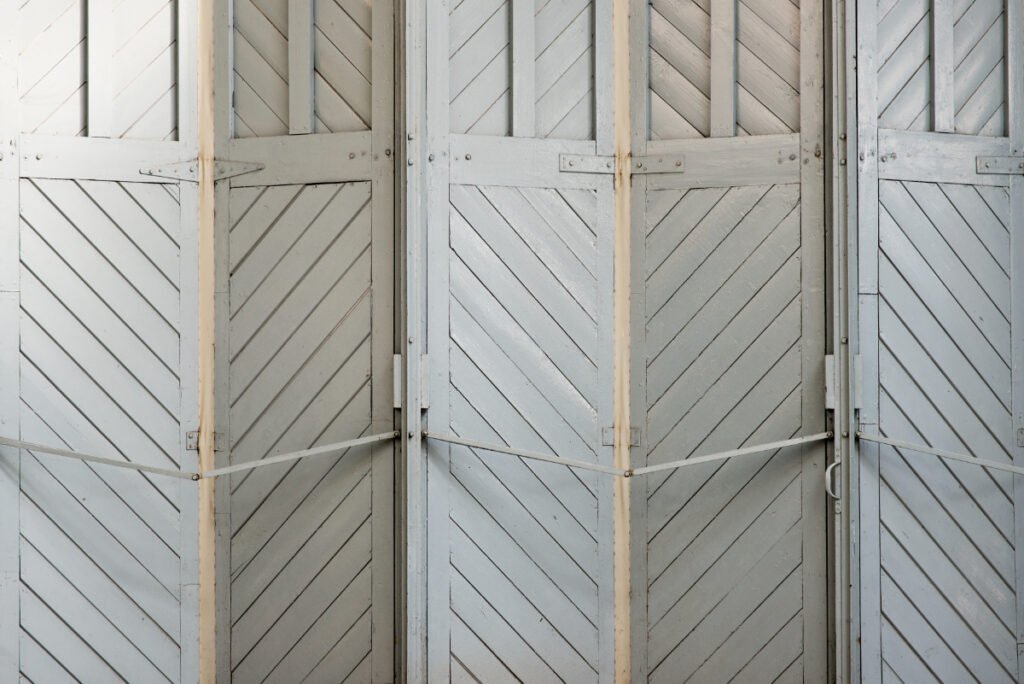
What Is It: A folding door is a type of sectional door with vertical joints, fittings, and panels that slide and fold against one side of the wall and allow a clear opening from the other adjacent side.
Folding doors are convenient and stylish. They require horizontal space to slide and fold but don’t reduce your garage’s height and provide a clear attic space. These doors can be quadra, tri, or bi-paneled, and you can easily customize these as per your door opening.
Plus, they connect well to the surroundings and can be partially opened or closed as per choice. However, they are tricky to insulate and cannot hold onto thicker polystyrene or styrofoam insulation.
In addition, folding doors have some air gaps between their vertical panels that let in cold air and might hike your energy bill.
| Average Weight | 100 – 110lbs |
| Average Lifespan | 20 – 25 years |
| Standard Size | 6 X 4 feet |
| Decor | Modern or Classical |
| Popular Materials | Steel, Wood, PVC, Vinyl |
Pros:
- Don’t reduce the height of your garage
- Provide a clear driveway and garage space
- Can be filled or reglazed and makes garage door repair easier
- Can be partially opened or shut
Cons:
- Do not provide proper insulation
- Manually operated
Clean all the door tracks and hardware with a soft-bristled brush or vacuum them using a soft-nozzle tip for smoother door operations.
Comparison of Top Garage Door Alternatives
| Parameter | Barn Doors | Sheet Metal | Roller Screen | Carriage | Sliding | Faux wood | Folding |
| Cost | High | Low | Low | High | High | High | Low |
| Weather Resistance | High | Low | Low | Moderate | High | High | Moderate |
| Decor | Traditional | Modern | Rustic | Modern | Mid-century Modern | Villa | Classical |
| Weight | High | Low | Low | High | Moderate | Low | Moderate |
| Operation | Automatic | Manual | Manual | Manual | Automatic | Automatic | Manual |
How Do You Close Your Garage Doors Permanently?
Garage doors can be permanently closed if you want a fully insulated, air-tight space inside or plan to convert your garage door to a living room, gym, or office. And we have two more alternatives to help you convert your garage space into a functional room.
Build a Wall at the Garage Door Opening
Brick or stone walls are expensive but will offer full insulation and allow you to curate a living space inside your garage. Alternatively, you can install a stud wall and place drywall panels to save costs. And of course! You can add a small window and a steel or wood entry door to access the space from the outside and allow more natural light inside.
Cost of Dry-wall installation: $0.4 – 0.65 per square foot.
Build a Wall Behind the Garage Door
Close the garage door permanently and build a thin brick or stud wall behind it to convert your garage into a livable space. This way, you can create a small buffer zone and add extra insulation to your garage shutter. You can always add a tiny glass or steel door to the stud wall to access the outside whenever you want.
What Is the Most Affordable Garage Door Alternative?
Roll-up screen doors are the most cost-efficient and inexpensive alternatives for a garage door. They do not incur significant installation or mounting costs and are cheaper to repair and maintain. These cost around $100 for a hinged screen and $300 for sliding and retractable screens.
Can I Change My Garage Door to a Normal Door?
Yes, you can change your garage door to a standard entry door, but you’ll need planning permission, especially if your house is in the conservation area.
Garage doors protect your garages and tools from harsh weather and burglars but are expensive. Hence, you can use the different garage door alternatives from our list to curate friendly spillover spaces and protect from the heat, rain, and snow in the most economical way.
However, although some of these alternatives are durable and long-lasting, they cannot be automated as efficiently as a typical garage door. So, if you still want to consider conventional garage doors, learn about types of garage doors before picking one!

